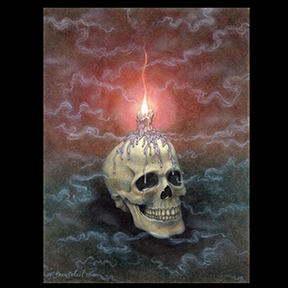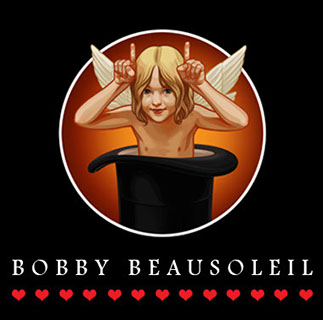
Shadowplay
Questing in the Underworld
Bobby BeauSoleil
 n the dark, eyes shut, there are no limits to what may be seen as the mind shines its light into the mystery. Patterns shyly emerge, tentatively; hints of forms, suggestions of potential ... things. Then retreating as a vagrant thought disturbs the surface reflections on the nightpool. Swirls of subtle color arising once again as stillness returns. Disciplined practice is required, therefore, to resolve what may be seen in that place where there is no light.
n the dark, eyes shut, there are no limits to what may be seen as the mind shines its light into the mystery. Patterns shyly emerge, tentatively; hints of forms, suggestions of potential ... things. Then retreating as a vagrant thought disturbs the surface reflections on the nightpool. Swirls of subtle color arising once again as stillness returns. Disciplined practice is required, therefore, to resolve what may be seen in that place where there is no light.
The visionary artist quests within the mystic sphere, climbing the forbidden tree. The immortal worm, releasing its tail from its mouth to speak, offers an invitation to know what is hidden. There is the price, always the price when ignorance is challenged with new insights.
One artist may be enticed to conjure cheerful visions of puffy clouds in sunny skies, rainbows and butterflies and myriad pleasant delights. Another artist may look upon such a Happyville as a trap for the soul, like a sticky confection prepared to ensnare the unwary insect, where obligatory smiles become frozen in rictus as the truth sinks in.
We are endowed with free will to choose the path that is right for us. Some will choose the path less obvious — while knowing full well, or not, that all paths lead, ultimately, to the light. The one who braves the darkness in the underworld may learn to conquer fear once and for all and thus pierce through the veil of nescience to liberation and the light of Truth, to wear the golden fleece as a mantle.
Fear conjures demons and monsters out of the gloom. Courage summons the hero to vanquish them. The venturesome artist forges on undaunted, unconcerned with any arbitrary judgements about where the sunny dream ends and the nightmare assumes dominion. If a hideous monstrosity with a gaping hungry maw full of sharp teeth emerges out of the black, the artist as hero must make the effort to draw it into visibility where the light makes it a known thing and it can do no harm.
What appears to be frightening is a tease, a thing that both repels and attracts, drawing us out of complacency, stirring emotion to wake us up. The disturbance is goading, encouraging a willingness to stand and face down the fearsome beast within and defeat it. There is, after all, no one inside oneself but oneself.
This is what we do. This is our purpose as artists who delve in the nightside realms. Only some are invested with this ability; and so, intended by the artist or not, the rendering becomes a service to those not endowed with this special sight. In this way all may benefit.
In the artist's rendering a tree root may turn into a writhing serpent. The psyche enjoys playing with such tricks. The sword of discrimination empowers the awakened to know what is real and what is device or hallucination. The one who wields it skillfully can fool without being fooled.
Like a diamond pendant displayed upon a nest of black velvet, any subject will appear more brilliant when surrounded by darkness. In this context the black is a scheme that may be used to draw attention to an object the artist deems to be important.
In the realm of total darkness there is nothing that can be seen with the physical eyes. But shine the light of consciousness into it with purity of intent and archetypal gods and goddesses and angels may appear projected on the chid akasha, the screen of the mind, resplendent and ablaze in the luminance of their own radiance. Of course the dark things that also frequent that realm may only be perceived as the light of awareness touches them along the edges, limning only outlines, or glinting on the wet parts. The dark things so enjoy their aspect of mystery; it's why they cloak themselves darkly.
Turning up frequently in art of the imagination, at times as an incidental element, often enshrined as the object of focus, is the death's-head. Found in graveyards and tombs and temples, on battlefields, discovered in caves and digs, and in dark places of the mind, appearing vacant and empty or leering with seemingly sinister intent, the human skull incites a primal fascination like no other object we are likely to encounter in the world.
For human beings, sentience has endowed the death's-head with the property of symbolizing the nexus of life and death, and the great mystery of conscious existence, representing the brief and temporary nature of physical embodiment and the gateway we must all pass through when leaving it behind. The skull seems to mock any revulsion, horror, mystification or even longing we may feel when looking upon it. Silently it speaks to us as a reflection of who we once were as an embodied soul even while we still occupy the body. Don't get too cocky, it seems to say; your encounter with eternity is just around the bend.
An image of a fanged skeleton seated in full lotus, a halo of holy light emanating, speaks eloquently of human aspiration, the animal's yearning for transcendence on the mortal plane and beyond to the inward immortal Self. Unless we are living dead inside we live our lives flirting with death in one way or another, like daredevils. Living for an afterlife in some Tomorrowland is a fool's errand, even when knowing that one's existence is eternal, for it robs one of intimacy with the present moment, the precious now.
The death of someone close can bring on a darkness that is deeper and more profound than any other. We all have the capacity if not the ability to survive that one too, the thief who steals from the heart. Making it through the experience of abysmal grief with integrity restored, no other thing that may lurk in the dark can possibly be much of a threat.
So we revel in the mystery resident in dark places. Alas, our revelry may be confounded by those pesky good versus evil moralisms frequently velcroed to the domains of light and dark. All too often imaginative art with dark themes is dismissed as representative of some sort of satanic intent when that is not necessarily so and often not the case.
In western culture the purity of intent in imagery that comes out of hidden realms may be poisoned by the legacy of Holy Rome’s strategic vilification of the elder gods of pagan people in the Middle Ages, used as a tool for subjugation during the conquest and occupation of pagan lands to the north. The artist as seeker is obliged to sort through the errors in religious dogmas and other superstitious nonsense to find reconciliation. The singularity of divine existence will never be fooled into dividing itself into opposing sides ... except in play.
For this we have our riches of myth and fairy tales, long a fountain of inspiration to storytellers and visual artists. Allegory is a powerful tool for instructing and learning the art of using the sword of discrimination effectively. The adversary — and we all have one; psychologists call it the ego — must be laid low and transformed into an ally if the pearl of great price is to be achieved.
We can avoid getting into trouble by reminding ourselves frequently that attributing moral properties to light and dark is meant as metaphor in the telling of the great stories. Context is the ground of meaning. We may use references to darkness to symbolize ignorance and point to the light to indicate higher understanding, while knowing full well that the truth does not take sides. Consider that prey and predator alike may choose a dark and shadowy place to hide in, and take turns basking in the sunlight.
The interplay of light and shadow is not a war. It is a dance, a sublime penumbral ballet in perfect symmetry, joined and unified by the song.
Fall 2017
© 2014 Bobby BeauSoleil and BHDesigns. All Rights Reserved. Images are copyrighted to their respective owners. Go to our Privacy Policy.
